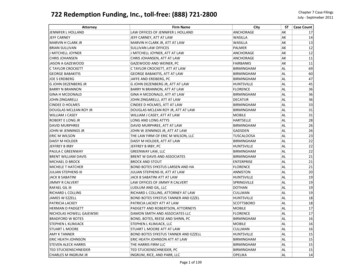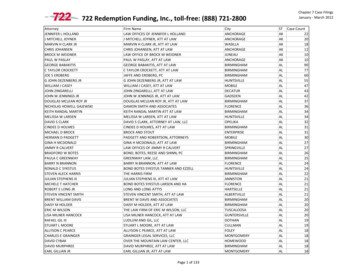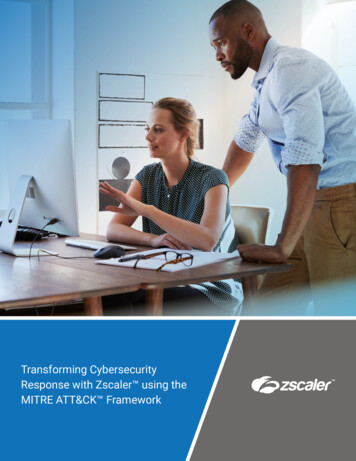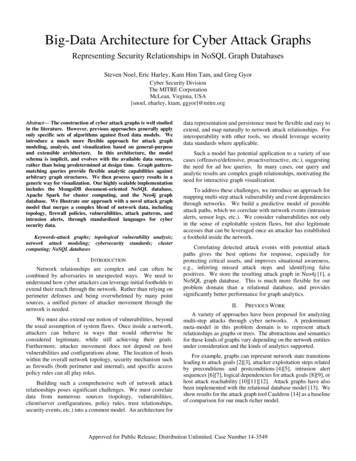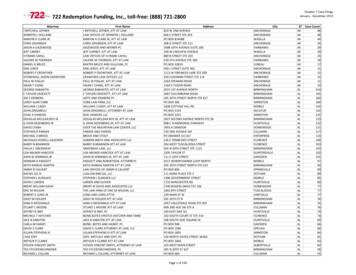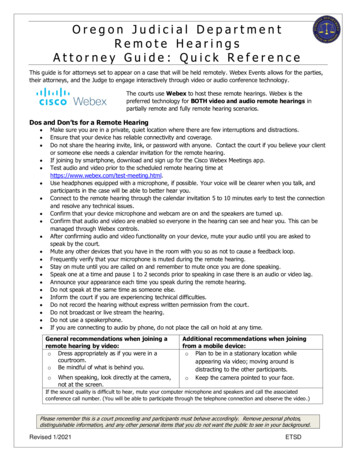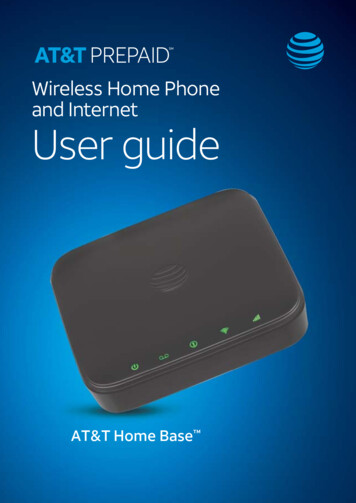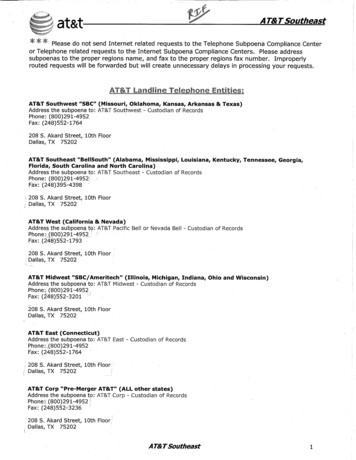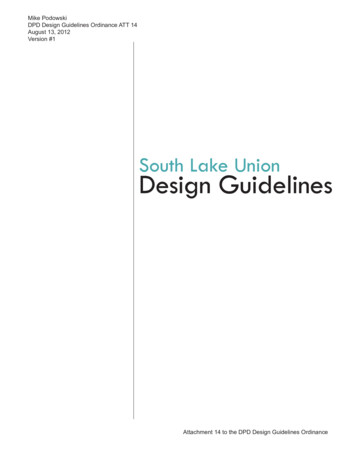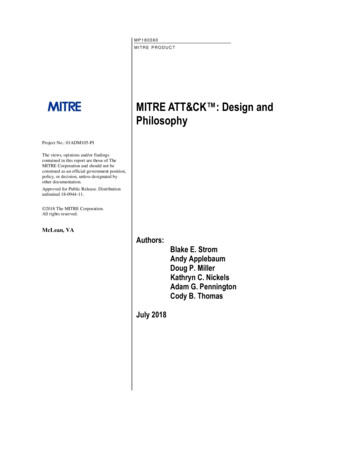
Transcription
MP180360MI TR E P R O D U C TMITRE ATT&CK : Design andPhilosophyProject No.: 01ADM105-PIThe views, opinions and/or findingscontained in this report are those of TheMITRE Corporation and should not beconstrued as an official government position,policy, or decision, unless designated byother documentation.Approved for Public Release. Distributionunlimited 18-0944-11. 2018 The MITRE Corporation.All rights reserved.McLean, VAAuthors:July 2018Blake E. StromAndy ApplebaumDoug P. MillerKathryn C. NickelsAdam G. PenningtonCody B. Thomas
AbstractThe MITRE ATT&CK knowledgebase describes cyber adversary behavior and provides acommon taxonomy for both offense and defense. It has become a useful tool across many cybersecurity disciplines to convey threat intelligence, perform testing through red teaming oradversary emulation, and improve network and system defenses against intrusions. The processMITRE used to create ATT&CK, and the philosophy that has developed for curating newcontent, are critical aspects of the work and are useful for other efforts that strive to createsimilar adversary models and information repositories.iii 2018 The MITRE Corporation. All Rights ReservedApproved for Public Release. Distribution unlimited 18-0944-11.
This page intentionally left blank.iv 2018 The MITRE Corporation. All Rights ReservedApproved for Public Release. Distribution unlimited 18-0944-11.
Executive SummaryThis paper discusses the motivation behind the creation of ATT&CK, the components describedwithin it, its design philosophy, how the project has progressed, and how it can be used. It ismeant to be used as an authoritative source of information about ATT&CK as well as a guide forhow ATT&CK is maintained and how ATT&CK-based knowledge bases are created for newtechnology-domains and platforms.v 2018 The MITRE Corporation. All Rights ReservedApproved for Public Release. Distribution unlimited 18-0944-11.
PrefaceThis paper documents the published version of ATT&CK as of April 2018. MITRE hasannounced plans to evolve and expand ATT&CK throughout 2018 [1]. This paper will bemaintained as a living document and will be updated as significant changes are made toATT&CK and the process used to maintain the content within ATT&CK.vi 2018 The MITRE Corporation. All Rights ReservedApproved for Public Release. Distribution unlimited 18-0944-11.
Table of ContentsIntroduction . 11.1Background and History . 1ATT&CK Use Cases . 3The ATT&CK Model . 53.1The ATT&CK Matrix . 53.2Technology Domains . 63.3Tactics . 73.4Techniques . 73.4.13.5Groups . 103.5.13.6Group Object Structure . 10Software . 113.6.13.7Technique Object Structure . 7Software Object Structure . 11ATT&CK Object Model Relationships . 12The ATT&CK Methodology . 144.1Conceptual . 144.1.1Adversary’s Perspective. 144.1.2Empirical Use. 154.1.2.1Sources of Information . 154.1.2.2Un(der)reported Incidents. 154.1.3Abstraction . 154.2Tactics . 174.3Techniques . 174.3.1What Makes a Technique. 174.3.1.1Naming . 174.3.1.2Types of Technique Abstraction. 184.3.1.3Technical References . 184.3.1.4Adversary Use . 184.3.1.5Technique Distinction. 194.3.2Creating New Techniques . 204.3.3Enhancing Existing Techniques . 214.3.4Named Adversary Groups Using Techniques. 21vii 2018 The MITRE Corporation. All Rights ReservedApproved for Public Release. Distribution unlimited 18-0944-11.
4.3.5Incorporation Threat Intelligence on Groups and Software within ATT&CK . 214.3.5.14.3.6Ungrouped Use of Techniques . 22Examples of Applying the Methodology for New Techniques . 22Summary . 26References . 27viii 2018 The MITRE Corporation. All Rights ReservedApproved for Public Release. Distribution unlimited 18-0944-11.
List of FiguresFigure 1. The ATT&CK for Enterprise Matrix . 6Figure 3. ATT&CK Model Relationships . 12Figure 4. ATT&CK Model Relationships Example . 13Figure 5. Abstraction Comparison of Models and Threat Knowledge Databases . 16ix 2018 The MITRE Corporation. All Rights ReservedApproved for Public Release. Distribution unlimited 18-0944-11.
List of TablesTable 3. ATT&CK Technology Domains . 7Table 4. ATT&CK Technique Model . 8Table 5. ATT&CK Group Model . 10Table 6. ATT&CK Software Model . 11x 2018 The MITRE Corporation. All Rights ReservedApproved for Public Release. Distribution unlimited 18-0944-11.
This page intentionally left blank.xi 2018 The MITRE Corporation. All Rights ReservedApproved for Public Release. Distribution unlimited 18-0944-11.
IntroductionMITRE’s Adversarial Tactics, Techniques, and Common Knowledge (ATT&CK) is a curatedknowledge base and model for cyber adversary behavior, reflecting the various phases of anadversary’s attack lifecycle and the platforms they are known to target. ATT&CK originated outof a project to enumerate and categorize post-compromise adversary tactics, techniques andprocedures (TTPs) against Microsoft Windows systems to improve detection of maliciousactivity. It has since grown to include Linux and MacOS , and has expanded to cover precompromise tactics and techniques, and technology-focused domains like mobile devices. At ahigh-level, ATT&CK is a behavioral model that consists of the following core components: Tactics, denoting short-term, tactical adversary goals during an attack (the columns); Techniques, describing the means by which adversaries achieve tactical goals (theindividual cells); Documented adversary usage of techniques and other metadata (linked to techniques).ATT&CK is not an exhaustive enumeration of attack vectors against software. Other MITREefforts such as CAPEC [2] and CWE [3] are more applicable to this use case.1.1 Background and HistoryATT&CK was created out of a need to systematically categorize adversary behavior as part ofconducting structured adversary emulation exercises within MITRE’s Fort Meade Experiment(FMX) research environment. Established in 2010, FMX provided a “living lab” capability thatallowed researchers access to a production enclave of the MITRE corporate network to deploytools, test, and refine ideas on how to better detect threats. MITRE began researching datasources and analytic processes within FMX for detecting advanced persistent threats (APTs)more quickly under an “assume breach” mentality. Cyber game exercises were conducted on aperiodic basis to emulate adversaries within the heavily sensored environment and hunting wasperformed to test analytic hypotheses against the data collected. The goal was to improve postcompromise detection of threats penetrating enterprise networks through telemetry sensing andbehavioral analytics [4]. The primary metric for success was “How well are we doing atdetecting documented adversary behavior?” To effectively work towards that goal, it proveduseful to categorize observed behavior across relevant real-world adversary groups and use thatinformation to conduct controlled exercises emulating those adversaries within the FMXenvironment. ATT&CK was used by both the adversary emulation team (for scenariodevelopment) and the defender team (for analytic progress measurement), which made it adriving force within the FMX research.The first ATT&CK model was created in September 2013 and was primarily focused on theWindows enterprise environment. It was further refined through internal research anddevelopment and subsequently publicly released in May 2015 with 96 techniques organizedunder 9 tactics. Since then, ATT&CK has experienced tremendous growth based oncontributions from the cybersecurity community. Based on the methodology used to create thefirst ATT&CK model, a complementary knowledge base called PRE-ATT&CK was created tofocus on “left of exploit” behavior, and ATT&CK for Mobile was created to focus on behavior1 2018 The MITRE Corporation. All Rights ReservedApproved for Public Release. Distribution unlimited 18-0944-11.
in the mobile-specific domain. As of April 2018, Enterprise ATT&CK now includes 219techniques across Windows, Linux, and Mac.2 2018 The MITRE Corporation. All Rights ReservedApproved for Public Release. Distribution unlimited 18-0944-11.
ATT&CK Use CasesAdversary Emulation – The process of assessing the security of a technology domain byapplying cyber threat intelligence about specific adversaries and how they operate to emulatethat threat. Adversary emulation focuses on the ability of an organization to verify detectionand/or mitigation of the adversarial activity at all applicable points in their lifecycle.ATT&CK can be used as a tool to create adversary emulation scenarios to test and verifydefenses against common adversary techniques. Profiles for specific adversary groups can beconstructed out of the information documented in ATT&CK (see Cyber Threat Intelligence usecase). These profiles can also be used by defenders and hunting teams to align and improvedefensive measures.Red Teaming – Applying an adversarial mindset without use of known threat intelligence forthe purpose of conducting an exercise. Red teaming focuses on accomplishing the end objectiveof an operation without being detected to show mission or operational impact of a successfulbreach.ATT&CK can be used as a tool to create red team plans and organize operations to avoid certaindefensive measures that may be in place within a network. It can also be used as a researchroadmap to develop new ways of performing actions that may not be detected by commondefenses.Behavioral Analytics Development – By going beyond traditional indicators of compromise(IoCs) or signatures of malicious activity, behavioral detection analytics can be used to identifypotentially malicious activity within a system or network that may not rely on prior knowledgeof adversary tools and indicators. It is a way of leveraging how an adversary interacts with aspecific platform to identify and link together suspicious activity that is agnostic or independentof specific tools that may be used.ATT&CK can be used as a tool to construct and test behavioral analytics to detect adversarialbehavior within an environment. The Cyber Analytics Repository1 (CAR) is one example ofanalytic development that could be used as a starting point for an organization to developbehavioral analytics based on ATT&CK.Defensive Gap Assessment – A defensive gap assessment allows an organization to determinewhat parts of its enterprise lack defenses and/or visibility. These gaps represent blind spots forpotential vectors that allow an adversary to gain access to its networks undetected orunmitigated.ATT&CK can be used as a common behavior-focused adversary model to assess tools,monitoring, and mitigations of existing defenses within an organization’s enterprise. Theidentified gaps are useful as a way to prioritize investments for improvement of a securityprogram. Similar security products can also be compared against a common adversary behaviormodel to determine coverage prior to purchasing.SOC Maturity Assessment – An organization’s Security Operations Center is a criticalcomponent of many medium to large enterprise networks that continuously monitor for active1https://car.mitre.org3 2018 The MITRE Corporation. All Rights ReservedApproved for Public Release. Distribution unlimited 18-0944-11.
threats against the network. Understanding the maturity of a SOC is important to determine itseffectiveness.ATT&CK can be used as one measurement to determine how effective a SOC is at detecting,analyzing, and responding to intrusions. Similar to the defensive gap assessment, a SOCMaturity assessment focuses on the processes a SOC uses to detect, understand, and respond tochanging threats to their network over time.Cyber Threat Intelligence Enrichment – Cyber threat intelligence covers knowledge of cyberthreats and threat actor groups that impact cybersecurity. It includes information about malware,tools, TTPs, tradecraft, behavior, and other indicators that are associated to threats.ATT&CK is useful for understanding and documenting adversary group profiles from abehavioral perspective that is agnostic of the tools the group may use. Analysts and defenderscan better understand common behaviors across many groups and more effectively map defensesto them and ask questions such as “what is my defensive posture against adversary groupAPT3?” Understanding how multiple groups use the same technique behavior allows analysts tofocus on impactful defenses that span may types of threats. The structured format of ATT&CKcan add value to threat reporting by categorizing behavior beyond standard indicators.Multiple groups within ATT&CK use the same techniques. For this reason, it is notrecommended to attribute activity solely based on the ATT&CK techniques used. Attribution toa group is a complex process involving all parts of the Diamond Model [5], not solely on anadversary’s use of TTPs.4 2018 The MITRE Corporation. All Rights ReservedApproved for Public Release. Distribution unlimited 18-0944-11.
The ATT&CK ModelThe basis of ATT&CK is the set of individual techniques that represent actions that adversariescan perform to accomplish objectives. Those objectives are represented by the tactic categoriesthe techniques fall under. This relatively simple representation strikes a useful balance betweensufficient technical detail at the technique level and the context around why actions occur at thetactic level.3.1 The ATT&CK Matrix The relationship between tactics and techniques can be visualized in the ATT&CK Matrix. Forexample, under the Persistence tactic (this is the adversary’s goal – to persist in the targetenvironment), there are a series of techniques including AppInit DLLs, New Service, and5 2018 The MITRE Corporation. All Rights ReservedApproved for Public Release. Distribution unlimited 18-0944-11.
Scheduled Task. Each of these is a single technique that adversaries may use to achieve the goalof persistence. Figure 1 depicts the ATT&CK Matrix for enterprise systems.Figure 1. The ATT&CK for Enterprise Matrix3.2 Technology DomainsATT&CK is organized in a series of “technology domains” - the ecosystem an adversaryoperates within that provides a set of constraints the adversary must circumvent or takeadvantage of to accomplish a set of objectives. To date MITRE has defined two technologydomains – Enterprise (representing traditional enterprise networks) and Mobile (for mobilecommunication devices). Within each technology domain, ATT&CK defines multiple“platforms” - the system an adversary is operating within. A platform may be an operatingsystem or application (e.g. Microsoft Windows). Techniques can apply to multiple platforms.Table 1 lists the platforms currently defined for ATT&CK technology domains.6 2018 The MITRE Corporation. All Rights ReservedApproved for Public Release. Distribution unlimited 18-0944-11.
The scope of ATT&CK also expands beyond technology domains with PRE-ATT&CK. PREATT&CK covers documentation of adversarial behavior during requirements gathering,reconnaissance, and weaponization before access to a network is obtained. It is independent oftechnology and models an adversary’s behavior as they attempt to gain access to an organizationor entity through the technology they leverage, spanning multiple domains.Table 1. ATT&CK Technology DomainsTechnology DomainEnterpriseMobilePlatform(s) definedLinux, macOS, WindowsAndroid, iOS3.3 TacticsTactics represent the “why” of an ATT&CK technique. It is the adversary’s tactical objective:the reason for performing an action. Tactics serve as useful contextual categories for individualtechniques and cover standard notations for things adversaries do during an operation, such aspersist, discover information, move laterally, execute files, and exfiltrate data. Tactics are treatedas “tags” within ATT&CK where a technique is associated or tagged with one or more tacticcategories depending on the different results that can be achieved by using a technique.Each tactic contains a definition describing the category and serves as a guide for whattechniques should be within the tactic. For example, Execution is defined as a tactic thatrepresents techniques that result in execution of adversary-controlled code on a local or remotesystem. This tactic is often used in conjunction with initial access as the means of executing codeonce access is obtained, and lateral movement to expand access to remote systems on a network.Additional tactic categories may be defined as needed to more accurately describe adversaryobjectives. Applications of the ATT&CK modeling methodology for other domains may requirenew or different categories to associate techniques even though there may be some overlap withtactic definitions in existing models.3.4 TechniquesTechniques represents “how” an adversary achieves a tactical objective by performing an action.For example, an adversary may dump credentials to gain access to useful credentials within anetwork. Techniques may also represent “what” an adversary gains by performing an action.This is a useful distinction for the Discovery tactic as the techniques highlight what type ofinformation an adversary is after with a particular action. There may be many ways, ortechniques, to achieve tactical objectives, so there are multiple techniques in each tactic category.3.4.1 Technique Object StructureThese terms represent sections and important information included within each technique entrywithin the Enterprise ATT&CK model. Items are annotated by tag if the data point is aninformational reference on the technique that can be used to filter and pivot on, and field if theitem is a free text field used to describe technique-specific information and details. Items markedwith relationship indicate fields that are associated to technique entity relationships with groups7 2018 The MITRE Corporation. All Rights ReservedApproved for Public Release. Distribution unlimited 18-0944-11.
and software that use the technique. Table 2 lists all of the data items currently defined fortechniques in ATT&CK. Data items marked with * denote the element is required and additionalinformation about specific requirements dependent on tactic category is in the description.Table 2. ATT&CK Technique ModelData dPlatform*TagSystem ermissions*TagData Source*TagDescriptionThe name of the techniqueUnique identifier for the technique within theknowledgebase. Format: T####.The tactic objectives that the technique can be usedto accomplish. Techniques can be used to performone or multiple tactics.Information about the technique, what it is, what it’stypically used for, how an adversary can takeadvantage of it, and variations on how it could beused. Include references to authoritative articlesdescribing technical information related to thetechnique as well as in the wild use references asappropriate.The system an adversary is operating within; couldbe an operating system or application (e.g. MicrosoftWindows). Techniques can apply to multipleplatforms.Additional information on requirements theadversary needs to meet or about the state of thesystem (software, patch level, etc.) that may berequired for the technique to work.The lowest level of permissions the adversary isrequired to be operating within to perform thetechnique on a system. *Required for privilegeescalation.The level of permissions the adversary will attain byperforming the technique. Only applies totechniques under the privilege escalation tactic. Mayhave multiple entries if effective permissions can beset when technique is executed. *Required forprivilege escalationSource of information collected by a sensor orlogging system that may be used to collectinformation relevant to identifying the action beingperformed, sequence of actions, or the results ofthose actions by an adversary. The data source listcan incorporate different variations of how theaction could be performed for a particular technique.This attribute is intended to be restricted to a defined8 2018 The MITRE Corporation. All Rights ReservedApproved for Public Release. Distribution unlimited 18-0944-11.
Supports RemoteTagDefense Bypassed*TagCAPEC IDFieldContributorTagExamplesRelationship/ FieldDetection*FieldMitigation*Fieldlist to allow analysis of technique coverage based onunique data sources. (For example, “what techniquescan I detect if I have process monitoring in place?”)If the technique can be used to execute something ona remote system. Applies to execution techniquesonly.If the technique can be used to bypass or evade aparticular defensive tool, methodology, or process.Applies to defense evasion techniques only.*Required for defense evasion.Hyperlink to related CAPEC entry on the CAPECsite.List of non-MITRE contributors (individual and/ororganization) from first to most recent thatcontributed information on, about, or supporting thedevelopment of a technique.Example fields are populated on a technique pagewhen a group or software entity is associated to atechnique through documented use. They describethe group or software entity with a brief descriptionof how the technique is used. The example of how aspecific adversary uses a technique is a directreference to their procedures, or exact way of howthey perform a technique on a system.High level analytic process, sensors, data, anddetection strategies that can be useful to identify atechnique has been used by an adversary. Thissection is intended to inform those responsible fordetecting adversary behavior (such as networkdefenders) so they can take an action such as writingan analytic or deploying a sensor. There should beenough information and references to point towarduseful defensive methodologies. There could bemany ways of detecting a technique but ATT&CKand MITRE do not endorse any particular vendorsolution. Detection recommendations shouldtherefore remain vendor agnostic, recommendingthe general method and class of tools rather than aspecific tool. Detection may not always be possiblefor a given technique and should be documented assuch.Configurations, tools, or processes that prevent atechnique from working or having the desiredoutcome for an adversary. This section is intended toinform those responsible for mitigating against9 2018 The MITRE Corporation. All Rights ReservedApproved for Public Release. Distribution unlimited 18-0944-11.
adversaries (such as network defenders orpolicymakers) to allow them to take an action suchas changing a policy or deploying a tool. Mitigationrecommendations should remain vendor agnostic,recommending the general method rather than aspecific tool. Mitigation may not always be possiblefor a given technique and should be documented assuch.3.5 GroupsKnown adversaries that are tracked by public and private organizations and reported on in threatintelligences reports are tracked within ATT&CK under the Group object. Groups are defined asnamed intrusion sets, threat groups, actor groups, or campaigns that typically represent targeted,persistent threat activity. ATT&CK primarily focuses on APT groups though it may also includeother advanced groups such as financially motivated actors.Groups can use techniques directly or employ software that implements techniques.3.5.1 Group Object StructureItems are annotated by tag if the data point is an informational reference on the group that can beused to filter and pivot on, and field if the item is a free text field used to describe techniquespecific information and details. Items marked with relationship indicate fields that areassociated to technique entity relationships with techniques and software that use the technique.Data items marked with * denote the element is requiredTable 3. ATT&CK Group ModelData dAlias DescriptionsFieldTechniques Used*Relationship/ FieldDescriptionThe name of the adversary group.Unique identifier for the group within theknowledgebase. Format: G####.Alternative names that refer to the same adversarygroup in threat intelligence reporting.A description of the group based on public threatreporting. It may contain dates of activity, suspectedattribution details, targeted industries, and notableevents that are attributed to the group’s activities.Section that can be used to describe a groups’ aliaseswith references to the report used to tie the alias tothe group name.List of techniques that are used by the group with afield to describe details on how the technique isused. This represents the group’s procedure (in the10 2018 The MITRE Corporation. All Rights ReservedApproved for Public Release. Distribution unlimited 18-0944-11.
SoftwareRelationship/ Fieldcontext of TTPs) for using a technique. Eachtechnique should include a reference.List of software that the group has been reported touse with a field to describe details on how thesoftware is used.3.6 SoftwareAdversaries commonly use different types of software during intrusions. Software can representan instantiation of a technique, so they are also necessary to categorize within ATT&CK forexamples on how techniques are used. Software is broken out into three high-level categories:tools, utilities, and malware. Tool - Commercial, open-source, or publicly available software that could be used by adefender, pen tester, red teamer, or an adversary for malicious purposes that generally isnot found on an enterprise system. Examples include PsExec, Metasploit, Mimikatz, etc. Utility - Software generally available as part of an operating system that is likely alreadypresent in an environment. Adversaries tend to leverage existing functionality on systemsto gather information and perform actions. Examples include Windows utilities such asNet, netstat, Tasklist, etc. Malware - Commercial, custom closed source, or open source software intended to beused for
within it, its design philosophy, how the project has progressed, and how it can be used. It is meant to be used as an authoritative source of information about ATT&CK as well as a guide for how ATT&CK is maintained and how ATT&CK-based knowledge ba
